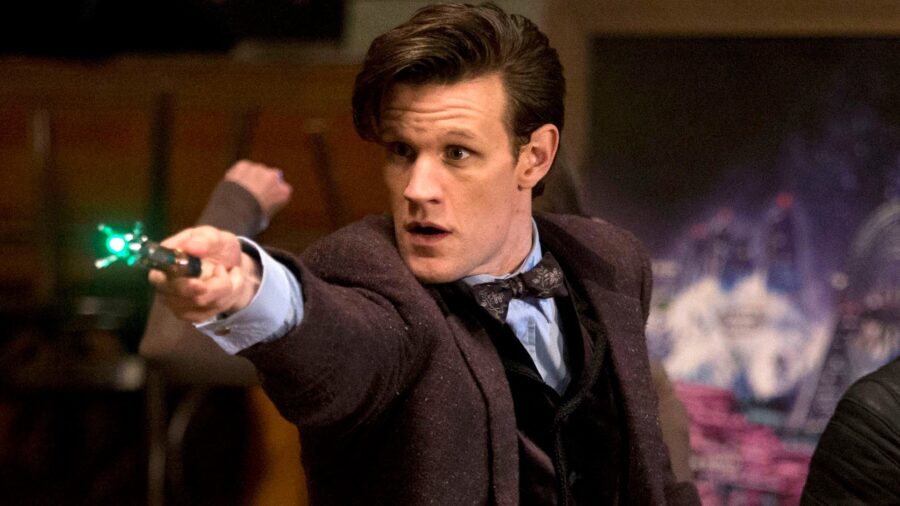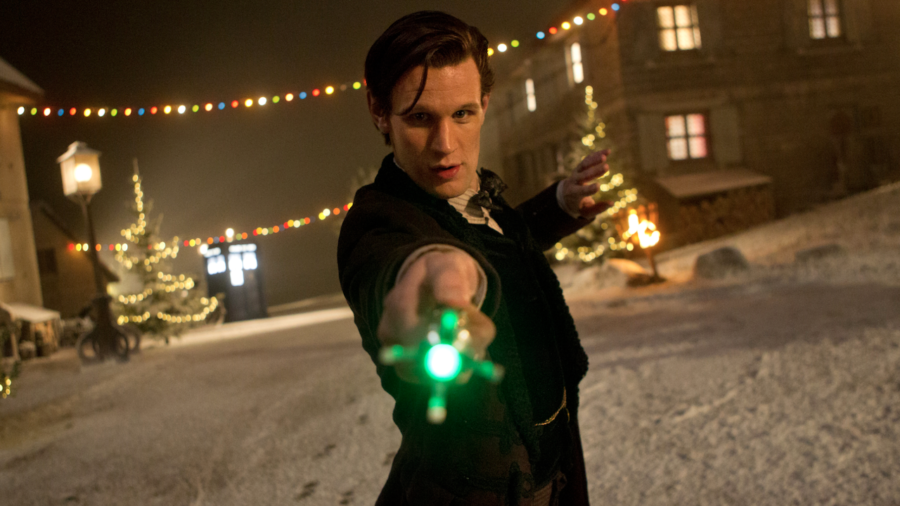Three Things We Loved About Matt Smith’s Doctor Who Farewell

“And now it’s time for one last bow, like all your other selves. Eleven’s hour is over now, the clock is striking Twelve’s.” In 2013, Matt Smith’s journey as the Doctor reached its end, and with it the time of the Eleventh Twelfth Thirteenth Eleventh Doctor.
It had quite a challenge ahead of it, following on the heels of the epic “Day of the Doctor,” but it succeeded admirably by telling a large story through a small, personal lens.
It bookended the Matt Smith era with countless callbacks, wrapped up many of the dangling questions and bits of mythology showrunner Steven Moffat had left us with over the past several seasons, and gave Matt Smith a proper, memorable exit. Before handing him a new face (and kidneys). Here are three things we loved about “The Time of the Doctor.”
The Funny
Doctor Who makes us laugh as often as it thrills us or wallops us in the heartstrings, and “The Time of the Doctor” didn’t forget to break up all the bittersweet farewells with some jolly good laughs.
The opening sequence, where Matt Smith’s Doctor gets stuck in a sort of teleportation Russian roulette, dropping into one unwelcoming spaceship after another, was a great way to establish the story and get us laughing.
And while things were going to take a darker turn as the episode continued, the Silly Doctor was in full effect for the first half: prancing about naked (at least he put on a hologram), oversharing thanks to a troublesome truth field, cooking a turkey via time travel, and bantering with a Cyberman head. (Alas, poor Handles…we barely knew you.)
When it came time to say goodbye, to clear the stage for the new guy? Of course, the Doctor’s new kidneys wiped away all those tears. (Kudos must also be given for a brilliant use of Matt Smith’s haircut.)
The Puzzle Pieces

While Steven Moffat’s tenure as showrunner has definitely had some rough patches, he’s always been a great idea man. I remember the conversation I had with a friend after watching the “Silence in the Library”/”Forest of the Dead” two-parter where he was remarking on just how many crazy sci-fi ideas were crammed into those episodes.
A planet-wide library. Predators that lived in your shadow. A true love whose relationship unfolded backwards. “Donna Noble has been saved.” Any one of those could have served as the basis for an episode, but Moffat’s script threw them all into a blender and made something even more awesome.
That’s how I feel again, having watched “Time of the Doctor.” While Matt Smith’s tenure as the Doctor hasn’t always been perfect, looking back at it now it’s amazing how well Moffat pulled together all the disparate ideas and mysteries he’s given us over the years.
“The Time of the Doctor” not only satisfactorily explained questions such as the Doctor’s fate on Trenzalore, the regeneration-limit problem, “Silence will fall”, and the importance of the Doctor’s name, it tied those resolutions into things even further back than I’d expected.
The fact that the crack in Amy Pond’s wall came back into play was a great surprise, and the way it was used made sure there was still plenty of story to be explored while simultaneously closing out the Eleventh Doctor’s story in a lovely way. After how “The Day of the Doctor” ended, I was genuinely surprised when Handles said the word “Gallifrey,” and I didn’t expect the Time Lords to be addressed again this soon.
All the more satisfying, then, that the Time Lords and the Doctor’s homeworld played an integral part in this story, but without actually resolving those ongoing plot threads.
The Regeneration

In the weeks leading up to “The Time of the Doctor,” Moffat had commented that Matt Smith’s regeneration would be very different from that of David Tennant. The Tenth Doctor’s regeneration was, after all, treated much more like a death than it had before, culminating in Tennant’s unforgettable, heartbreaking “I don’t want to go.”
That’s powerful stuff, emotionally, but also seemed a bit unlikely for a character who had already gone through this process many times over the centuries. But Moffat also acknowledged that, while it isn’t the same as death, it could still be a frightening prospect: you’re going to turn into somebody else, with a new face and new personality.
Even though everything you are will still be there, in many ways, an entirely new person will be at the wheel. That sounds vaguely terrifying if you ask me.
Kudos, then, for the way they handled it in “Time.” Rather than a single regeneration, we get two. First, there was a violent, cathartic, triumphant regeneration as the Time Lords granted the Doctor another full set of regenerations, and with it, the means to deal with those pesky Daleks that had been such a problem for several hundred years.
But then we get, in essence, a second regeneration. This one is quieter and more emotional, where the Doctor acknowledges with sadness that regeneration may not be as bad as death, but it’s still very much an ending.
And just when we thought we were going to get through this thing without tearing up, here comes Amelia Pond to see her Raggedy Doctor off. I’m still kind of a mess.
With “The Time of the Doctor,” Moffat neatly wrapped up the arc of the show during Matt Smith’s years, answering many questions and offering new ones, in the end leaving us feeling as if we’ve just finished a beloved book and are excited to pick out the next one.
More importantly, he regenerated not just the Doctor, but the series’ mythology. In interviews, he said that he wanted to help ensure the show lasted another 50 years. Whether that happens remains to be seen, but in closing out the story of Matt Smith and the Eleventh Doctor, he’s deftly set the stage for Doctor Who to carry on at least that long. And when the Doctor runs through these new lives? Well, that’ll be somebody else’s problem to solve…











